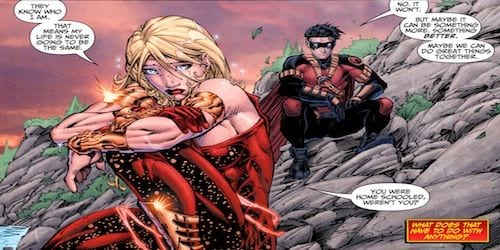
One of the great narrative strengths of the Teen Titans is its inherent paradox. At the heart of the book is the story of kid sidekicks seeking to break out of the shadow of their forbears. Emulating the conflicting and ambivalent emotions of youth, these characters are always trying to reject the restrictions placed upon them. Yet they are simultaneously seeking to honor to the legacy founded by the very ones they are often rebelling against. This makes for a genuinely interesting narrative tension. But it also resonates as fundamentally authentic, in ways other superhero stories often cannot. As part of the final week’s releases of DC’s New 52, writer Scott Lobdell exploits this tension with aplomb in Teen Titans #1.
The story follows Red Robin trying to thwart the attempts of a secret organization who is tracking down young metahumans for some nefarious purpose. The first issue is able to quickly hit many of the important plot points that recur in these types of stories. There is the reckless would-be hero, Kid Flash, who ends up endangering innocent lives instead of saving them. Wonder Girl assumes the role of the newly empowered hero who fears that her new abilities will destroy her life. And Red Robin is the leader who must corral them all together and forge a team despite the teen angst and hormones. The story might seem a little heavy-handed for some readers (as with Kid Flash all but saying, “You’re not the boss of me!”) but overall, it is a fun read that does its job well.
There are two moments in the particular that really allude to the thematic power that has made the Teen Titans a fan favorite over the years. The first is when Robin glances at a picture of he and Batman together and muses, “Look what you started. Seriously. What were thinking”? In that short bit of dialogue so much of the tension between and sidekick and hero is revealed. This is a question that no doubt emerges from a character who still wishes to follow in the footsteps of his mentor, but is now independent and old enough to question the judgment of a person who would put that responsibility onto a child’s young shoulders. This expertly prefaces future conflict with the older generation of heroes and leaves the doors open for exploration on the concepts of legacy and heritage that have made the Titans such an integral part of the DC mythos.
It is also an excellent acknowledgment of the historical significance of the Robin character as the first truly successful vehicle for young fans to project themselves into the world of superheroes and fight alongside their favorite crime fighters.
The second magical moment of the book comes when Red Robin, responding to Cassie’s worry that her life will never be the same, replies, “Maybe we can do great things together”. This is another moment that might strike some readers as cheesy and maybe send a few eyes rolling. And yet it constitutes a very necessary part of what makes stories centered around younger characters interesting: their youthful optimism. This single line embodies so much of what redeems their angst and rebellion, justifies their overzealousness, and makes fans want to cheer their exploits. It rejects the seriousness of the older heroes, and the cynicism of some readers.
One of the main goals for DC’s relaunch was to grab readers who may never have picked up a comicbook before while avoiding alienating longtime readers. Teen Titans #1 is, in my opinion, one of books that truly fulfills this agenda. It finds a great equilibrium between the fun that made many of us first pick up comics, and the narrative strength that kept us reading them.

![Call for Papers: All Things Reconsidered [MUSIC] May-August 2024](https://www.popmatters.com/wp-content/uploads/2024/04/all-things-reconsidered-call-music-may-2024-720x380.jpg)



